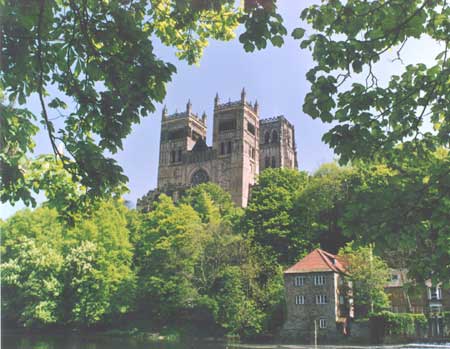 |
Mirror Image, 41 Windsor Terrace, South Gosforth, Newcastle upon Tyne NE3 1YL
Telephone: (0191) 2851202 E-mail: mirrorimage@northumbria.info
[Home | Architecture | Bridges | Castles | Churches | Sculpture | Where is it?]
 |
|
It also had an immense wealth of plate, jewels and books associated with St. Cuthbert's Shrine. The most precious of the books was St. Cuthbert's Book, now known as The Lindisfarne Gospels. It is known as the first, and some argue the finest, English work of art. The most recent research suggests that the Gospels were created around 720 AD in honour of St. Cuthbert, Bishop of Lindisfarne, whp played a seminal role in the creation of a unified Church in England. At some time in the 10th C. Provost Aldfrith of Chester-le-Street added a translation in Northumbrian English, and a note 'Bishop Eadfrith of Lindisfarne originally wrote this book in honour of God and St. Cuthbert and the whole company of saints whose relics are on the island'. It probably took two years of work for the Gospels to be completed. It was then carried, along with the body of St. Cuthbert, around the North East by monks who were fearful of it falling into the hands of marauding vikings. The Saint's body and the Gospels spent about 100 years at Chester-le-St before another evacuation to Ripon where another Northumbrian saint, Wilfred, had built an abbey. Later, the monks once again travelled north looking for a permanent resting place for the relics. The site they chose, a loop in the river Wear, offered a reasonably easy defensive position and this became known as Durham. When the conquering Normans arrived in the 11th C. they recognised the military, religious and political significance of the place and its treasures. By honouring St. Cuthbert with the construction of a great church the Normans placated the locals with a demonstartion of respect for local traditions. It is known that The Lindisfarne Gospels were in Durham Cathedral in 1104 when St. Cuthbert's body was moved to a new location behind the High Altar. There is also an indication that they may have been returned to Lindisfarne, Holy Island, for a time. In 1534 came the Reformation when King Henry VIII used his determination to break with Rome as an excuse to raid the wealth of the Church in England. His commisioners travelled far and wide collecting gold and silver crosses, chalices and jewel encrusted manuscripts. The probability is that the Gospels were taken to London where the precious metals and stones were taken from its binding and placed in the treasury. The rest of the weighty volume ended up in the library of the Tower of London. In the early part of the 17th C. it was sold to a book collector, Sir Robert Cotton and upon his death his collection was handed over to the fledgling British Museum and subsequently the British Library. In 1987 the Lindisfarne Gospels returned North to Durham Cathedral to be displayed to mark the 1300th anniversary of the death of St. Cuthbert. In 1996, and again in 2000, they were loaned to the Laing Art Gallery in Newcastle as part of the Treasures of the Lost Kingdom of Northumbria exhibition. There is a campaign to return them to the North permanently. The Lindisfarne Gospels Exhibition has an interactive touchscreen version of the book called 'Turning the Pages' and is on permanent display at the Lindisfarne Heritage Centre on Holy Island. |
A Visitors Book is available if you would like to make any comments or requests.
The following pages were designed by MIRROR IMAGE. All photographs taken by Ray Urwin©.
For more information please contact mirrorimage@northumbria.info